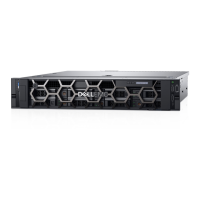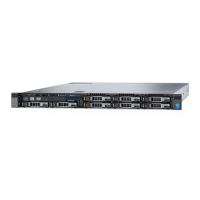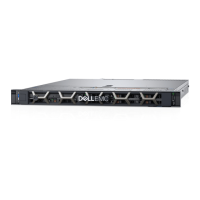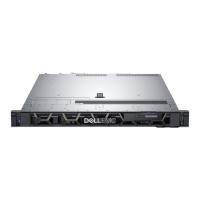General memory module installation guidelines
Memory Congurations
NOTE: Memory congurations that fail to observe these guidelines can prevent system from booting, stop responding
during memory conguration, or operating with reduced memory.
The PowerEdge R7425 system supports Flexible Memory Conguration, enabling the system to be congured and run in any valid
chipset architectural conguration. The following are the recommended guidelines for installing memory modules:
• RDIMMs and LRDIMMs must not be mixed.
• x4 and x8 DRAM based memory modules cannot be mixed.
• Populate memory module sockets only if a processor is installed. For single-processor systems, sockets A1 to A16 are available.
For dual-processor systems, sockets A1 to A16 and sockets B1 to B16 are available.
• Populate all the sockets with white release tabs rst, followed by the black release tabs.
• In a dual-processor conguration, the memory conguration for each processor should be identical. For example, if you populate
socket A1 for processor 1, then populate socket B1 for processor 2, and so on.
• Memory modules of dierent capacities is not supported.
• Populate eight memory modules per processor (one DIMM per channel) at a time to maximize performance.
• For best system performance, populate one DIMM per channel by plugging DDR4-2667 DIMM on the rst slot of each channel,
which is the DIMM slot with white release tab.
Memory RAS features
Reliability, availability, and serviceability (RAS) features help keep the system online and operational without signicant impact to
performance, and can decrease data loss and crashing due to errors. RAS aids in rapid, accurate diagnosis of faults which require
service.
Table 20. Supported RAS features
Feature Description
Dense conguration optimized prole Increased memory reliability can be a result from this selectable
platform prole that adjusts parameters to reduce faults
regarding refresh rates, speed, temperature, and voltage
Memory demand and patrol scrubbing Demand scrubbing is the ability to write corrected data back to
the memory once a correctable error is detected on a read
transaction. Patrol scrubbing proactively searches the system
memory, repairing correctable errors.
Recovery from single DRAM device failure (SDDC) Recovery from Single DRAM Device Failure (SDDC) provides
error checking and correction that protects against any single
memory chip failure and multi bit errors from any portion of a
single memory chip.
Failed DIMM isolation This feature provides the ability to identify a specic failing
DIMM channel pair, thereby enabling the user to replace only the
failed DIMM pair.
Memory mirroring Memory mirroring is a method of keeping a duplicate (secondary
or mirrored) copy of the contents of memory as a redundant
backup for use if the primary intra-socket memory fails. The
mirrored copy of the memory is stored in memory of the same
processor socket.
Memory address parity protection This feature provides the ability to detect transient errors on the
address lines of the DDR channel.
30

